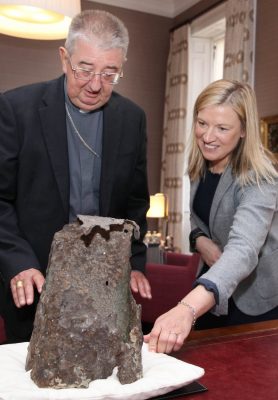
By Cian Molloy - 17 September, 2020
The unique quality of Glendalough – the scenic valley in the Wicklow National Park where St Kevin founded a monastic city 1,400 years ago – must be protected for future generations, says the Archbishop of Dublin.
Speaking at the launch of a new exhibition at the National Museum of Ireland in Kildare Street, Dublin, Archbishop Diarmuid Martin said: “Glendalough is unique. We have to ensure that in developing its potential in the future, we never lose its originality – peace, prayerfulness and refreshing silence.”
One of the exhibits on display at the museum is the Knockatemple Hand-bell, an artefact dating from the 8th or 9th century, which has been in the possession of the archdiocese since the 1920s. It is believed that a curate at St Mary’s Church, the pro-Cathedral, bought the bell at an auction in 1915.

NMI Keeper of the Antiquities Maeve Sikora discussing the Knockatemple Bell with Archbishop Diarmuid Martin last September (Pic John McElroy).
It is known as the ‘Knockatemple Hand-bell’ because it was found during excavations in 1879 of a two-aisle stone-paved church at Knockatemple, a townland some seven miles from the Glendalough monastic city.
In his speech at the opening of the exhibition, Archbishop Martin mentioned an encounter he had the previous day with a group of women from Dublin’s north inner city who provide support to one another following the tragic loss of one, or more, or their children to drug abuse.
Over the years, the archdiocese has provided some financial support for the group’s activities, one of which is providing the grieving mothers with some respite from their situation, which can be quite severe: for example, some of them ‘inherited’ their children’s debts to drug dealers and these illegal debts are often ruthlessly pursued by criminal gang leaders.
“They need to have an opportunity to get away from the unrelenting harshness of their situation,” explained the archbishop. “When I asked [them] what respite they liked best, I was immediately told Glendalough. I would never have thought of it, but these women, living in the harshness of making ends meet and coping with grief, found that even coming for a short visit, the silence and the beauty of Glendalough gave them just what they needed.”
The archbishop said he told the story to illustrate the fact that Glendalough is “still a place where prayer, silence and pilgrimage can be a lifesaving moment of respite and rest and peace for a group of forgotten troubled women today. And how many others!”.
However, the tranquillity of Glendalough is under threat because of its growing popularity. The visitors’ centre and the monastic city form the second most popular tourist attraction run by the Office of Public Works, which recorded nearly three-quarters of a million visitors in 2018. But those numbers represent only a small proportion of the total number of visitors, as most of those who go to Glendalough, especially those who use the car park at the upper lake, do not visit the OPW-run sites.
As the hustle and bustle of tourist traffic increases, can the peace, prayerfulness and refreshing silence of Glendalough remain?